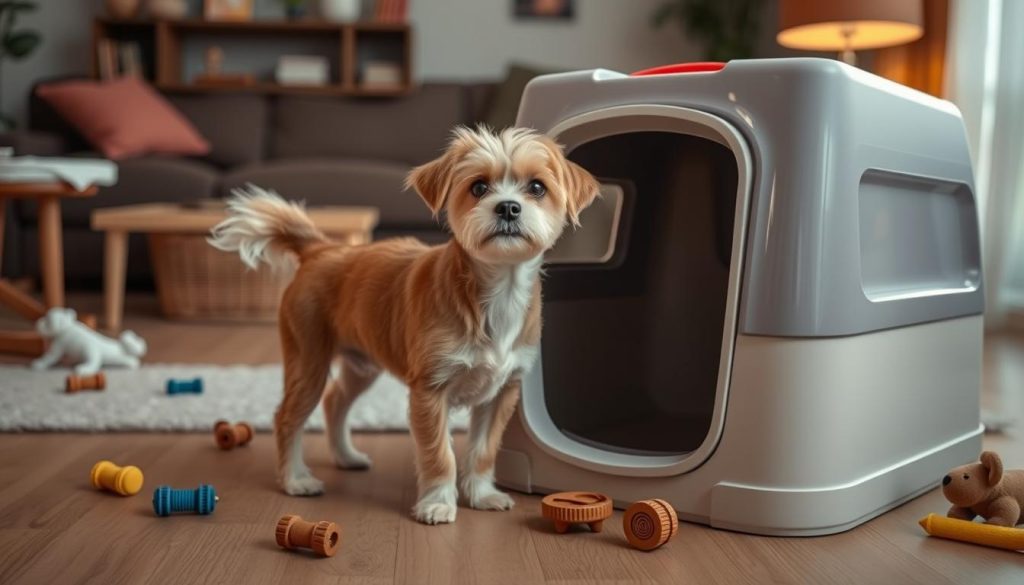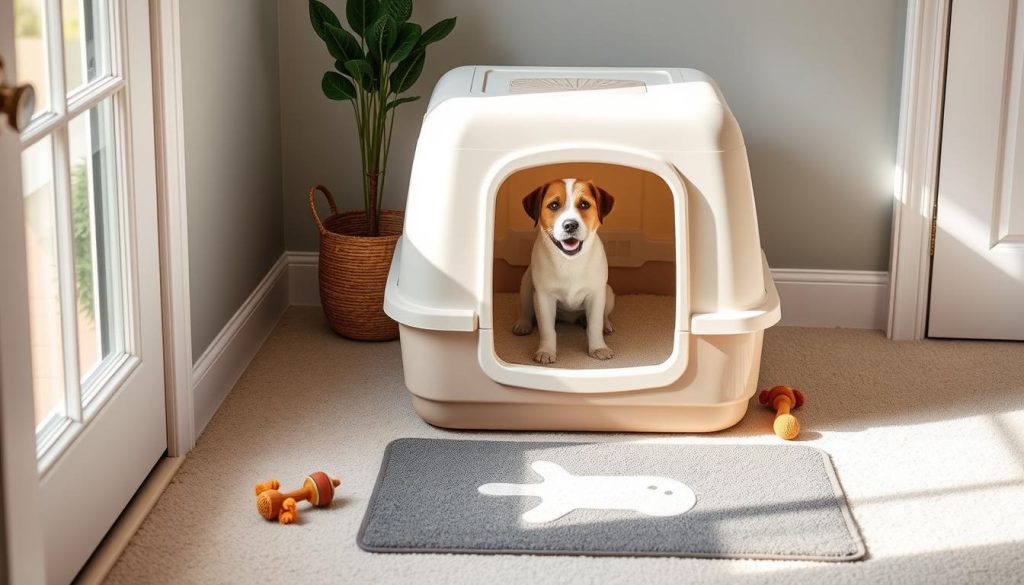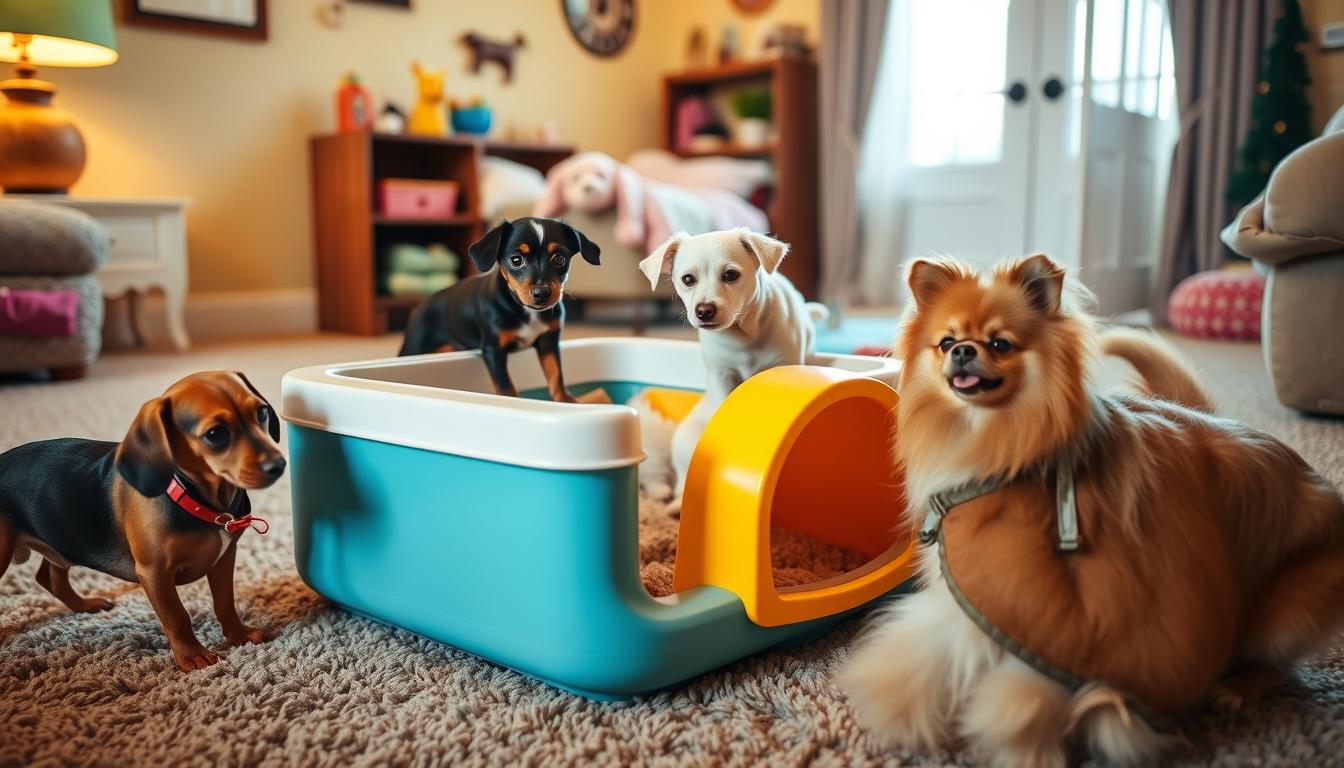Have you thought about training your dog to use a litter box? It might seem unusual, but it’s doable. A study by the American Society for the Prevention of Cruelty to Animals found that up to 80% of dogs can learn. But what makes a dog a good candidate for litter box training, and how can you help them succeed?
Litter box training is great for apartment dwellers or those without outdoor access. Small breeds like Yorkies and Chihuahuas often do well with it because of their size. With a consistent routine and positive rewards, your dog can master the litter box, even if they prefer going outside.
Introduction to Litter Training for Dogs
Litter box training for dogs might seem odd, but it’s a good choice for many pet owners. It’s especially useful for those living in apartments or without easy outdoor access. This method teaches dogs to use a litter box, just like cats do.
Training your dog to use a litter box has many perks. It’s convenient, keeps things clean, and helps reduce your dog’s stress when left alone. Yet, it also comes with its own set of challenges. These include a learning curve and the need for regular upkeep.
Teaching your dog to use a litter box takes time and effort. It’s a journey that requires patience and commitment. But with the right steps and a prepared space, your dog can learn to use the litter box reliably. This makes life better for both you and your pet.

Quick Recommendation : Our blog is filled with tips , tricks, and methods for training your dog. If you are seeking a comprehensive training program, we recommend the K9 Training Institute.
If you’re thinking about dog litter box training or just want to know more, this intro is for you. It offers key insights to help you teach your dog to use a litter box.
Setting Up the Perfect Litter Box Environment
Starting litter training for your dog requires careful planning. You need to think about your dog’s size and the space available. This ensures they use their litter box for relief.
Choosing the right litter box size is essential. It should have walls that are high enough to keep the litter in but low enough for your dog to get in and out easily.
Dogs don’t like the same litter as cats because of the texture. Paper pellets are a good choice for dogs. They absorb well and don’t make a mess when kicked out. Some people put puppy pads at the bottom for extra absorption and easy cleaning.

Quick Recommendation : Our blog is filled with tips , tricks, and methods for training your dog. If you are seeking a comprehensive training program, we recommend the K9 Training Institute.
Having a specific spot for the litter box is important for training. Pick a quiet, well-ventilated area in your home that your dog can easily get to. Being consistent and positive helps your dog get used to this new routine.
How to Train a Dog to Use a Litter Box
Training your dog to use a litter box is a great way to manage their bathroom habits. It’s especially helpful for small breeds or those living in apartments. The process requires patience, consistency, and positive reinforcement.
Start by placing the litter box in a quiet, easy-to-reach spot in your home. Puppies need to go every 1-2 hours, so make sure the box is accessible. Encourage your dog to explore the box by placing treats nearby or inside.
When it’s time for your dog to go, guide them to the litter box and say “go potty.” Reward them with praise and a treat right away if they use it correctly. This positive feedback will help them learn the right behavior.
Training consistently is crucial. Take your dog to the litter box after meals, naps, and before bed. Small dogs need to go more often because of their small bladders and high metabolism. Stay patient and persistent, and most dogs will learn in about six weeks.
Keep in mind, the litter box is just a temporary solution. It should be used until your dog is about 16 weeks old. Using positive reinforcement will help your dog use the litter box regularly and reduce accidents at home.
Ideal Candidates for Litter Box Training
Litter box training works well for many dogs, especially puppies and small breeds like Shih Tzu, Pugs, Maltese, and Pekingese. These dogs fit well in litter boxes because of their size. They also get along well with indoor living, where going outside for bathroom breaks is hard.
Dogs with mobility problems can find litter boxes helpful. They’re easier to get to than the outdoors, which is great for older dogs or those with arthritis. Training them to use a litter box can be a big help.
Even bigger dogs, like Golden Retrievers, Labrador Retrievers, and Standard Poodles, can learn to use a litter box. They need the right size litter box and consistent training. Positive rewards like treats and praise are key to their success.
Elderly dogs might need more time to get used to litter boxes. They have old habits to break. But, with patience and consistent training, they can learn too. Litter box training is a good option for dog owners in apartments or with little outdoor space. It makes bathroom time easier indoors.
Maintaining a Clean and Hygienic Litter Box
Keeping your dog’s litter box clean is key for their health and your home’s cleanliness. You should scoop out waste every day. Also, change the litter and clean the box with mild soap and water weekly to stop bacteria and smells.
Accidents outside the litter box need quick action with an enzyme cleaner. This removes stains and smells well, cutting down on future messes. Clumping litter is easy to clean, but non-clumping is better for young pups who might eat it.
Choose unscented litter for your dog since they might find scented ones too strong. Make sure the litter box has 2-3 inches of fresh litter. Also, it should be easy to get to with low sides to encourage use.
Keeping up with litter box care, like daily scooping and weekly deep cleaning, is vital. By following these tips for dog litter box cleaning and dealing with litter box accidents, you can keep your home smelling fresh. Your dog will stay happy and healthy too.
Conclusion
Litter box training is a good choice for dog owners, especially in apartments or with little outdoor space. It’s easy to teach your dog to use a litter box. This makes their bathroom needs easy and stress-free.
There are also other indoor potty options like pee pads and artificial grass pads. These can be great for small dogs or those who can’t get to the outdoors easily.
Training your dog to use a litter box has many benefits. It keeps your home clean and healthy. It stops harmful bacteria and bad smells. By training your dog, you make your home a better place for both of you.
Quick Recommendation : Our blog is filled with tips , tricks, and methods for training your dog. If you are seeking a comprehensive training program, we recommend the K9 Training Institute.

